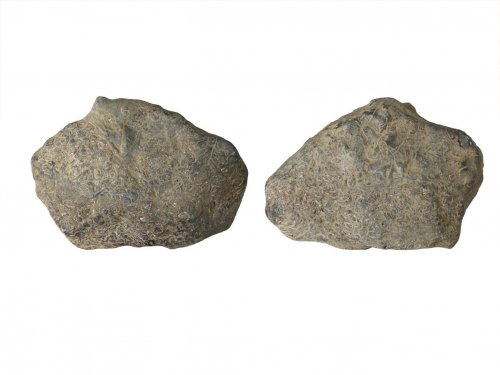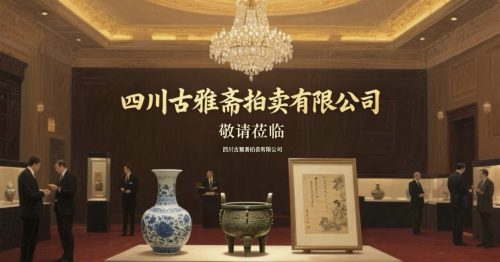贝类化石炭纪腕足类集群化石:3 亿年前的海洋生物群落 “活切片”

一、生命史诗:石炭纪海洋的 “群体肖像” 这块化石是石炭纪(约 3.5 亿年前)腕足类动物的集群埋藏标本,总长 28cm、宽 17cm、重 8.85kg,属于古生物收藏中罕见的 “群落级化石”。岩面布满密集的贝壳印记,每一枚贝壳都曾是独立的腕足动物 —— 这类动物形似现代贝壳,却有着独特的 “背壳 + 腹壳” 结构,与双壳类(如蛤蜊)的 “左右分壳” 截然不同。 从细节看,贝壳表面的放射状纹理与同心皱襞清晰可辨,部分区域还能看到壳体重叠的 “层积效应”—— 这是石炭纪浅海环境中,腕足类 “扎堆生存” 的生态特征:它们通过密集附着占据食物丰富的海域,形成了远古海洋中壮观的 “贝类森林”。 二、科研与收藏:双重价值的 “时光密码” 1、地质年代的 “金标准” 腕足类是石炭纪标准化石(地层 “时间印章”):它们仅繁盛于 3.5 亿 – 2.9 亿年前的石炭纪海洋,且不同种类的腕足类能精准对应特定地层。这块化石的 “群落埋藏” 模式(大量个体集中保存)为研究石炭纪海洋的生态结构、种群密度提供了直接线索 —— 要知道,绝大多数化石仅保存单一生物的零散残片,而 “群落级化石” 能还原远古海洋的 “社会关系”。
2. 收藏界的 “稀缺臻品” (1)体型碾压:石炭纪腕足类通常单枚壳体仅 5 – 10cm,而这块化石以 28cm 的 “群落规模” 呈现,相当于 “一整块岩石里嵌着数十只腕足”,在全球私人收藏中凤毛麟角; (2)历史厚重:它见证了石炭纪 “巨虫时代” 的海洋巅峰 —— 当时大气氧含量达 35%(现为 21%),催生了这类 “巨型无脊椎动物” 的演化奇迹; (3) 品相上佳:化石整体完整性强,贝壳纹理、群体排列未受后期地质运动严重破坏,属 “博物馆级展示品”。
三、陈设与传承:触摸远古的 “生态艺术品” 这块腕足类集群化石可作为空间陈设的 “自然史诗”:置于书房,它是 “3 亿年海洋生态” 的微观缩影;摆于展厅,它是 “古生物群落” 的震撼教材。其灰褐底色与密集的贝壳纹理,能适配新中式、工业风等多元美学风格,成为空间中 “低调而有力量的焦点”。 更难得的是,它承载着 “石炭纪海洋的社会史”—— 每一枚贝壳都是一只远古生物的 “生命印记”,而群体埋藏的形态则是它们 “集体生活” 的直接证据。这份 “可触摸的远古生态”,既适合赠予热爱自然的藏家,也可作为家族传承的 “文化信物”,让地球的 “生命史诗” 在手中延续。 四、收藏建议 腕足类集群化石对湿度与震动敏感,建议配定制底座(如深色实木或哑光金属),既保护化石,又强化其 “远古群落” 的视觉冲击力。 结语: 若您渴望收藏一段 “写在石头上的海洋社会学”,这块腕足类集群化石无疑是不容错过的珍品 —— 它不仅是古生物的 “群体传记”,更是人类与远古海洋对话的 “生态通道”。 Recommended Fine Brachiopod Fossil: A "Living Slice" of Marine Biota from the Carboniferous Period, 300 Million Years Ago I. The Epic of Life: A "Group Portrait" of Carboniferous Oceans This fossil is a mass burial specimen of brachiopods from the Carboniferous Period (approximately 350 million years ago). It measures 28cm in length, 17cm in width, and weighs 8.85kg, making it a rare "community-level fossil" in paleontological collections. The rock surface is covered with dense shell impressions. Each shell once belonged to an independent brachiopod—an animal that resembles modern shellfish but has a unique "dorsal + ventral shell" structure, distinctly different from bivalves (e.g., clams) which have "left-right divided shells." From a detailed view, the radial textures and concentric folds on the shell surfaces are clearly distinguishable. In some areas, the "lamination effect" of overlapping shells is visible—a characteristic ecological feature of brachiopods "living in clusters" in the shallow seas of the Carboniferous Period. They occupied food-rich marine areas through dense attachment, forming the spectacular "shell forests" of ancient oceans. II. Scientific Research & Collection Value: A "Time Code" with Dual Significance 1. The "Gold Standard" for Geological Dating Brachiopods are index fossils (the "time stamps" of rock strata) of the Carboniferous Period. They thrived exclusively in Carboniferous oceans from 350 to 290 million years ago, and different brachiopod species correspond precisely to specific rock strata. The "mass burial" pattern of this fossil (a large number of individuals preserved in concentration) provides direct clues for studying the ecological structure and population density of Carboniferous oceans. Notably, most fossils only preserve scattered fragments of single organisms, while "community-level fossils" can reconstruct the "social relationships" of ancient oceans. 2. A "Rare Treasure" in the Collection World Size Advantage: Individual Carboniferous brachiopod shells typically measure only 5–10cm. However, this fossil presents a "community scale" of 28cm—equivalent to "dozens of brachiopods embedded in a single piece of rock"—making it one of the rare treasures in global private collections. Profound Historical Significance: It witnessed the "peak of oceans" during the Carboniferous "Age of Giant Insects," when atmospheric oxygen content reached 35% (compared to 21% today), fostering the evolutionary miracle of such "giant invertebrates." Excellent Condition: The fossil maintains high overall integrity. Its shell textures and group arrangement remain largely undamaged by later geological movements, qualifying it as a "museum-grade exhibit." III. Display & Inheritance: A "Ecological Artwork" Touching the Ancient Past This brachiopod mass fossil can serve as a "natural epic" for spatial display: Placed in a study, it becomes a microcosm of "300 million years of marine ecology." Displayed in an exhibition hall, it acts as a striking educational tool for "ancient biological communities." Its gray-brown background and dense shell textures complement diverse aesthetic styles, such as new Chinese style and industrial style, becoming a "low-key yet powerful focal point" in any space. More notably, it carries the "social history of Carboniferous oceans"—each shell is a "life imprint" of an ancient organism, and the mass burial pattern is direct evidence of their "collective life." This "tangible ancient ecology" is not only suitable for gifting to nature-loving collectors but also serves as a "cultural keepsake" for family inheritance, allowing the "epic of Earth’s life" to continue in human hands. IV. Collection Recommendations Brachiopod mass fossils are sensitive to humidity and vibration. It is recommended to equip them with custom bases (e.g., dark solid wood or matte metal), which not only protect the fossil but also enhance the visual impact of its "ancient community" feature. Conclusion If you aspire to collect a piece of "marine sociology written in stone," this brachiopod mass fossil is undoubtedly an unmissable treasure. It is not only a "group biography" of ancient organisms but also an "ecological channel" for humans to communicate with the ancient oceans.



